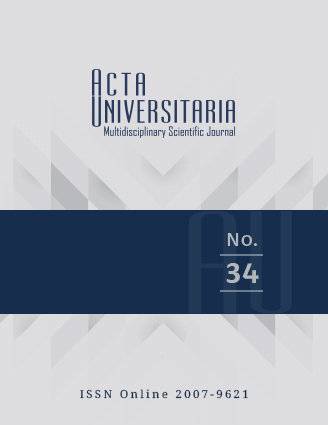Published 2024-10-23
How to Cite
Abstract
The probes used in the classroom for learning physics allow students to measure and display variables in real time. The main objective of these probes in education is to join science, technology, engineering, and mathematics (STEM), aiming to improve student learning. This research presents the optical and mechanical design, as well as the control algorithm, of a probe used for learning the concept of light transmittance. The probe consists of a single beam spectrophotometer and a digital camera connected to a computer. The components of the spectrophotometer were aligned and assembled into a housing manufactured with a 3D printer. The performance of the probe was evaluated by means of four standard samples used in spectroscopy, and its transmittance plots show characteristic maxima reported in the literature, which demonstrates a good performance of the probe for STEM education.
References
- Albert, D. R., Todt, M. A., & Davis, H. F. (2012). A low-cost quantitative absorption spectrophotometer. Journal of Chemical Education, 89(11), 1432-1435. https://doi.org/10.1021/ed200829d
- Botero-Valencia, J. S., Valencia-Aguirre, J., Durmus, D., & Davis, W. (2019). Multi-channel low-cost light spectrum measurement using a multilayer perceptron. Energy and Buildings, 199, 579-587.https://doi.org/10.1016/j.enbuild.2019.07.026
- Chaianantakul, N., Wutthi, K., Kamput, N., Pramanpol, N., Janphuang, P., Pummara, W., Phimon, K., & Phatthanakun, R. (2018). Development of mini-spectrophotometer for determination of plasma glucose. Spectrochimica Acta Part A: Molecular and Biomolecular Spectroscopy, 204, 670-676. https://doi.org/10.1016/j.saa.2018.06.107
- Davis, W., & Ohno, Y. (2010). Color quality scale. Optical Engineering, 49(3), 033602. https://doi.org/10.1117/1.3360335
- Farooq, M. U., Waseem, M., Mazhar, S., Khairi, A., & Kamal, T. (2015). A review on internet of things (IoT). International Journal of Computer Applications, 113(1), 1-7. https://doi.org/10.5120/19787-1571
- Gilbert, P. U. P. A., & Haeberli, W. (2007). Experiments on subtractive color mixing with a spectrophotometer. American Journal of Physics, 75(4), 313-319. https://doi.org/10.1119/1.2431654
- Gräb, P., & Geidel, E. (2019). Spectroscopic studies of food colorings. World Journal of Chemical Education, 7(2), 136-144. https://doi.org/10.12691/wjce-7-2-13
- Palmer, C., & Loewen, E. G. (2005). Diffraction grating handbook. Newport.
- Pearce, J. M. (2012). Building research equipment with free, open-source hardware. Science, 337(6100), 1303-1304. https://doi.org/10.1126/science.1228183
- Popov, E. K., Tsonev, L. V., & Loewen, E. G. (1991). Scalar theory of transmission relief gratings. Optics Communications, 80(5-6), 307-311. https://doi.org/10.1016/0030-4018(91)90414-9
- Shapovalov, Y. B., Bilyk, Z. I., Usenko, S. A., & Shapovalov, V. B. (2022, June). Systematic analysis of digital tools to provide STEM and science education. Journal of Physics: Conference Series, 2288(1), 2288. IOP Publishing. https://doi.org/10.1088/1742-6596/2288/1/012032
- Thomasson, K. A., Lofthus-Herschman, S., Humbert, M., & Kulevsky, N. (1998). Applying statistics in the undergraduate chemistry laboratory: experiments with food dyes. Journal of Chemical Education, 75(2), 231. https://doi.org/10.1021/ed075p231
- Vernon, L. P. (1960). Spectrophotometric determination of chlorophylls and pheophytins in plant extracts. Analytical Chemistry, 32(9), 1144-1150. https://doi.org/10.1021/ac60165a029
- Wenzel, T. (2023). Open hardware: From DIY trend to global transformation in access to laboratory equipment. PLoS Biology, 21(1), e3001931. https://doi.org/10.1371/journal.pbio.3001931.t001
- Wilson, M. V., & Wilson, E. (2017). Authentic performance in the instrumental analysis laboratory: Building a visible spectrophotometer prototype. Journal of Chemical Education, 94(1), 44-51. https://doi.org/10.1021/acs.jchemed.6b00515.17
- Yan, J. C., Ren, J., Ren, L. L., Jian, J. M., Yang, Y., Yang, S. F., & Ren, T. L. (2019). Development of a portable setup using a miniaturized and high precision colorimeter for the estimation of phosphate in natural water. Analytica Chimica Acta, 1058, 70-79. https://doi.org/10.1016/j.aca.2019.01.030
- Yanchapanta-Bastidas, V. N., Ormaza-Hugo, R. M., Sáez-Paguay, M. Á., & Pachacama-Choca, R. W. (2020). Construcción de un espectrómetro casero para el análisis de espectros de luz, mediante el software Spectral Workbench. Polo del Conocimiento: Revista científico-profesional, 5(7), 209-222. https://dialnet.unirioja.es/servlet/articulo?codigo=7518064

